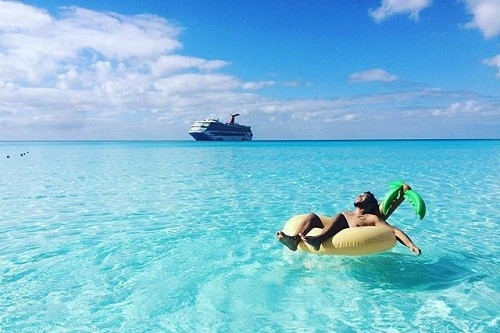Do you need a passport for a cruise to Mexico? Absolutely! Cruises to Mexico offer an exciting way to experience its vibrant culture and stunning landscapes, and while some cruises allow entry with alternative documents, a passport ensures a smoother, worry-free experience, especially for LGBTQ+ travelers seeking safe and welcoming destinations through resources like gaymexico.net. Think of it as your key to unlocking the full potential of your Mexican adventure, ensuring seamless travel and peace of mind. For the latest travel guidelines and LGBTQ+ friendly travel tips, explore gay bars, gay clubs, and gay-friendly hotels, make sure to visit gaymexico.net.
1. Understanding Passport Requirements for Cruises
Do you need a passport for a cruise? Generally, for international travel, a passport is a must-have, but the world of cruises has a few interesting exceptions. So, when it comes to cruises, the rules aren’t always set in stone, especially when you’re thinking about your dream vacation to Mexico.
Closed-Loop Cruises: The Exception to the Rule
What is a closed loop cruise? A closed-loop cruise begins and ends in the same U.S. port. According to U.S. Customs and Border Protection (CBP), U.S. citizens on closed-loop cruises can often enter Mexico without a passport, offering a unique exception to standard travel regulations. This means if you’re starting and ending your cruise in, say, Los Angeles, and heading to destinations in Mexico, you might be able to leave your passport at home.
However, even with this exception, having a valid U.S. passport is always the safest bet, especially for LGBTQ+ travelers. Why? Because life happens. If you need to fly home unexpectedly from Mexico due to an emergency, you’ll need a passport. Plus, some shore excursions or activities might require it. A passport ensures you’re prepared for anything.
What Documents Can You Use Instead of a Passport for a Cruise?
If you are a U.S. citizen on a closed-loop cruise, you can typically use the following documents in place of a passport, but remember, a passport is always preferable:
- Original or Certified Copy of Birth Certificate: This document must be issued by a government authority and include a raised seal.
- Government-Issued Photo ID: This could be a driver’s license or a state-issued ID card.
These documents prove your citizenship and identity, allowing you to board the cruise and re-enter the United States.
Why a Passport is Always Recommended
Even though it’s possible to take a closed-loop cruise to Mexico without a passport, carrying one is highly recommended, especially for LGBTQ+ travelers. Here’s why:
- Unexpected Situations: If you need to fly back to the U.S. unexpectedly due to a medical emergency or other unforeseen circumstances, you’ll need a passport.
- Flexibility: A passport gives you more flexibility to explore beyond the immediate port areas. Some excursions or activities might require a passport.
- Peace of Mind: Traveling with a passport eliminates any potential stress or uncertainty about your ability to re-enter the United States.
For LGBTQ+ travelers, a passport can also be a crucial document in case of emergencies or if you need to seek assistance from U.S. embassies or consulates. Having a passport ensures you’re prepared for any situation, allowing you to focus on enjoying your vacation.
 Cruise Ship in Cozumel Mexico
Cruise Ship in Cozumel Mexico
Passport Alternatives for Cruises to Mexico: What LGBTQ+ Travelers Need to Know
Navigating travel requirements can be tricky, especially for LGBTQ+ individuals. While closed-loop cruises offer an alternative to passports, it’s essential to understand the implications fully. According to the U.S. Department of State, a passport is the ultimate travel document. Having one ensures you can handle any situation, from unexpected emergencies to spontaneous adventures. For LGBTQ+ travelers, this can mean added security and peace of mind, knowing you have the necessary documentation to access support from U.S. embassies or consulates if needed.
For more information on LGBTQ+ travel safety and resources in Mexico, check out gaymexico.net.
2. Mexico Cruise Options That Don’t Require a Passport (Sometimes)
What cruises go to Mexico without a passport? Several cruise lines offer exciting itineraries to Mexico that fall under the closed-loop cruise exception. Let’s explore some popular options, keeping in mind that while a passport might not be strictly required, it’s always a good idea to have one:
Baja California Cruises
Cruises to Baja California are a favorite for those departing from California ports like Los Angeles, Long Beach, and San Diego. These cruises often visit vibrant destinations like Ensenada and Cabo San Lucas.
- Ensenada: Known as the “Cinderella of the Pacific,” Ensenada offers a mix of cultural attractions, delicious cuisine, and outdoor activities. You can explore the famous La Bufadora blowhole, sample local wines, or enjoy water sports.
- Cabo San Lucas: This lively resort city is famous for its stunning beaches, vibrant nightlife, and iconic El Arco rock formation. Enjoy snorkeling, whale watching (seasonal), or simply relax on the beach.
These cruises usually last from three to five days, making them perfect for a quick getaway.
Western Caribbean Cruises
Some closed-loop cruises to the Western Caribbean include stops in Mexican ports like Cozumel and Costa Maya. These cruises typically depart from ports in Florida, Texas, or Louisiana.
- Cozumel: This island is a paradise for divers and snorkelers, with crystal-clear waters and vibrant coral reefs. You can also explore Mayan ruins, relax on beautiful beaches, or enjoy duty-free shopping.
- Costa Maya: Located on the Yucatán Peninsula, Costa Maya offers a mix of ancient Mayan history and beautiful beaches. Visit the nearby Chacchoben ruins, swim in the turquoise waters, or explore the jungle.
These cruises generally last from five to seven days, providing a more extended vacation experience.
Yucatán Cruises
Cruises to Yucatán typically stop at Progreso, which is close to Mérida.
- Progreso: Known for its long pier and access to Mayan culture. Visit the Mayan ruins of Uxmal or enjoy the local beaches.
Cruise Lines Offering Passport-Free Options
Many major cruise lines offer closed-loop cruises to Mexico, including:
- Carnival Cruise Line
- Royal Caribbean International
- Princess Cruises
- Norwegian Cruise Line
It’s always a good idea to check with the specific cruise line for their most up-to-date passport requirements and recommendations.
 Baja California Arch, Mexico
Baja California Arch, Mexico
Mexico Cruise Destinations Without a Passport: A Guide for LGBTQ+ Travelers
Planning a cruise to Mexico can be exciting, but it’s essential to consider the specific needs and concerns of LGBTQ+ travelers. While closed-loop cruises offer a passport alternative, it’s crucial to choose destinations known for their inclusivity and respect for LGBTQ+ rights. According to Equaldex, Mexico City and Puerto Vallarta are particularly LGBTQ+-friendly, with strong legal protections and vibrant gay scenes. When selecting your cruise itinerary, research the ports of call to ensure they align with your values and offer a welcoming environment.
For the latest information on LGBTQ+ travel in Mexico, including safety tips and destination guides, visit gaymexico.net.
3. Essential Documents for Cruises to Mexico
Even if you’re on a closed-loop cruise that doesn’t technically require a passport, you’ll still need to bring certain documents to board the ship and re-enter the United States. So, what documents do I need to cruise to Mexico?
Required Documents for U.S. Citizens
For U.S. citizens on closed-loop cruises, the following documents are typically accepted in lieu of a passport:
- Original or Certified Copy of Birth Certificate: This is a vital document that proves your U.S. citizenship. Make sure it’s an official copy issued by the city, county, or state where you were born.
- Government-Issued Photo ID: This could be a driver’s license, a state-issued ID card, or any other photo ID issued by a government agency.
These documents, when presented together, establish your identity and citizenship, allowing you to board the cruise and return to the United States.
Additional Documents to Consider
While the above documents might be sufficient for closed-loop cruises, it’s always wise to bring additional documentation to avoid any potential issues:
- Passport Card: This is a limited-use passport that’s valid for land and sea travel between the U.S., Canada, Mexico, Bermuda, and the Caribbean. It’s more convenient to carry than a traditional passport book.
- Trusted Traveler Program Cards: If you’re a member of a Trusted Traveler Program like Global Entry, NEXUS, or SENTRI, you can use your membership card as proof of identity and citizenship.
- Copies of Important Documents: Keep copies of your birth certificate, driver’s license, and any other important documents in a separate location from the originals. This can be helpful if the originals are lost or stolen.
Special Considerations for LGBTQ+ Travelers
For LGBTQ+ travelers, it’s especially important to ensure that your documents accurately reflect your legal name and gender. If you’ve legally changed your name or gender, make sure your identification documents are updated accordingly. If you’re traveling with a partner, it’s also a good idea to bring documentation that proves your relationship, such as a marriage certificate or a domestic partnership certificate. This can be helpful in case of emergencies or if you need to make medical decisions on behalf of your partner.
 Beautiful beach and ocean in Bermuda
Beautiful beach and ocean in Bermuda
What Documents Do You Need for a Cruise to Mexico?: Ensuring a Smooth Trip for LGBTQ+ Travelers
When planning a cruise to Mexico, having the right documents is critical, especially for LGBTQ+ travelers. According to the National Center for Transgender Equality, outdated or incorrect identification documents can lead to significant challenges, including denial of service or even harassment. Ensure your name and gender marker on your travel documents match your current legal identification. If you’ve recently transitioned, update your passport and other IDs to avoid potential issues.
For resources on updating your identification documents and navigating travel as a transgender or non-binary person, visit gaymexico.net.
4. Passport Requirements for Different Nationalities
Do you need a passport to go to Mexico if you’re not a U.S. citizen? The rules we’ve discussed so far primarily apply to U.S. citizens. If you’re a citizen of another country, the passport requirements for cruises to Mexico can be different. It’s essential to understand the specific regulations that apply to your nationality.
Citizens of Other Countries
If you’re not a U.S. citizen, you’ll generally need a valid passport to enter Mexico, even on a cruise. The specific requirements can vary depending on your nationality and the cruise itinerary.
- Visa Requirements: Some nationalities may also require a visa to enter Mexico. Check with the Mexican embassy or consulate in your country to determine if you need a visa.
- Passport Validity: Your passport should be valid for at least six months beyond your intended stay in Mexico. Some countries require even longer validity periods.
- Cruise Itinerary: The specific ports of call on your cruise can also affect the passport and visa requirements. Check with the cruise line to confirm the necessary documents for each destination.
Permanent Residents of the U.S.
If you’re a permanent resident of the U.S. (i.e., you have a Green Card), you’ll generally need to present your Green Card and a valid passport from your country of citizenship to enter Mexico. The passport requirements will depend on your nationality, as mentioned above.
Checking with the Cruise Line
Regardless of your nationality, it’s always a good idea to check with the cruise line directly to confirm the specific passport and visa requirements for your cruise. They can provide the most up-to-date information based on your itinerary and nationality.
 Hawaiian Cliffs and Beach
Hawaiian Cliffs and Beach
Passport Information for International LGBTQ+ Travelers to Mexico
For LGBTQ+ travelers from outside the U.S., understanding Mexico’s entry requirements is crucial. According to Human Rights Watch, while Mexico has made significant progress in LGBTQ+ rights, attitudes and laws can vary by region. Ensure your passport aligns with your gender identity to avoid potential issues. Some countries may have specific requirements for LGBTQ+ travelers, so research thoroughly before your trip.
For comprehensive information and resources on LGBTQ+ rights and travel in Mexico, visit gaymexico.net.
5. What If You Don’t Have a Passport?
What happens if you don’t have a passport and you’re planning a cruise to Mexico? While having a passport is always the best option, there are still a few things you can do if you find yourself without one:
Check the Cruise Requirements
First, confirm whether the specific cruise you’re planning to take qualifies as a closed-loop cruise. If it starts and ends in the same U.S. port, you might be able to use alternative documents like a birth certificate and a government-issued photo ID.
Apply for a Passport
If you have enough time before your cruise, the best course of action is to apply for a passport. The U.S. Department of State offers both routine and expedited passport services.
- Routine Service: This typically takes 6-8 weeks to process.
- Expedited Service: For an additional fee, you can expedite your passport application and receive it in 2-3 weeks.
- Emergency Passport: In some cases, you might be able to get an emergency passport if you have urgent travel plans due to a life-or-death emergency.
Consider a Different Cruise
If you don’t have a passport and can’t get one in time for your cruise, you might want to consider a different cruise that doesn’t require a passport. There are many domestic cruises to destinations like Alaska, Hawaii, and the Caribbean that don’t require a passport for U.S. citizens.
 Man Relaxing in the Caribbean waters
Man Relaxing in the Caribbean waters
No Passport, No Problem? Options for LGBTQ+ Cruises to Mexico
If you’re an LGBTQ+ traveler without a passport, don’t worry—you still have options. Prioritize cruises that offer passport alternatives and choose LGBTQ+-friendly destinations. According to IGLTA, destinations like Puerto Vallarta and Cancun are known for their welcoming attitudes and vibrant LGBTQ+ scenes. Focus on closed-loop cruises and ensure you have all necessary alternative documents.
For more information on LGBTQ+ travel options and resources in Mexico, visit gaymexico.net.
6. Tips for a Smooth Cruise Check-In
To ensure a smooth and stress-free check-in process for your cruise to Mexico, here are some helpful tips:
Arrive Early
Give yourself plenty of time to get to the port, go through security, and check in. Arriving early can help you avoid long lines and potential delays.
Have Your Documents Ready
Make sure you have all your required documents readily available, including your cruise tickets, photo ID, birth certificate (if applicable), and any other necessary paperwork.
Check the Cruise Line’s Website
Before your cruise, visit the cruise line’s website to review their specific check-in procedures and requirements. This can help you avoid any surprises or confusion on the day of your cruise.
Pack Smart
Be aware of any restrictions on what you can bring on board, such as prohibited items or limits on liquids. Packing smart can help you avoid delays during the security screening process.
Be Prepared for Security
Be prepared to go through security screenings, which may include metal detectors, bag searches, and other security measures. Follow the instructions of the security personnel and be patient and cooperative.
Ask Questions
If you have any questions or concerns during the check-in process, don’t hesitate to ask a cruise line employee for assistance. They’re there to help you and ensure that your check-in goes smoothly.
Online Check-In
Many cruise lines offer online check-in, which allows you to complete much of the check-in process from the comfort of your own home. This can save you time and hassle at the port.
 Baja California Arch, Mexico
Baja California Arch, Mexico
Smooth Sailing: Check-In Tips for LGBTQ+ Cruises to Mexico
For LGBTQ+ travelers, a smooth check-in can set the tone for a fantastic cruise. According to Stonewall, LGBTQ+ travelers sometimes face discrimination or misunderstanding during travel. Be prepared with all necessary documents, and consider bringing a copy of your marriage certificate or other proof of relationship if traveling with a partner. Knowing your rights and the cruise line’s policies can help address any potential issues.
For additional tips and resources for LGBTQ+ travelers, visit gaymexico.net.
7. What to Do in Case of an Emergency Without a Passport
If an emergency arises during your cruise to Mexico and you don’t have a passport, it’s essential to know how to handle the situation. What happens if you lose your ID on a cruise?
Contact the U.S. Embassy or Consulate
The first step is to contact the U.S. Embassy or Consulate in Mexico. They can provide assistance and guidance on how to obtain an emergency passport or other necessary documents.
Gather Documentation
Gather any documentation you have, such as copies of your birth certificate, driver’s license, or other forms of identification. This can help expedite the process of obtaining an emergency passport.
Contact Family or Friends
Reach out to family or friends in the U.S. and ask them to send you copies of your important documents, such as your passport, birth certificate, or driver’s license.
Cooperate with Local Authorities
Cooperate with local authorities and follow their instructions. They can provide assistance and support in navigating the emergency situation.
Contact the Cruise Line
Inform the cruise line about the emergency and ask for their assistance. They may be able to provide support and resources to help you resolve the situation.
Stay Calm
It’s important to stay calm and focused during the emergency. Panicking can make it more difficult to think clearly and make sound decisions.
 Sunset in Warwick Long Bay in Bermuda
Sunset in Warwick Long Bay in Bermuda
Emergency Preparedness: A Guide for LGBTQ+ Cruises to Mexico
For LGBTQ+ travelers, being prepared for emergencies is especially important. According to ILGA World, LGBTQ+ individuals may face unique challenges when traveling, including discrimination or lack of access to services. Keep a list of emergency contacts, including LGBTQ+ organizations in Mexico. Familiarize yourself with local laws and customs, and know where to seek help if needed.
For a directory of LGBTQ+ resources and support in Mexico, visit gaymexico.net.
Address: 3255 Wilshire Blvd, Los Angeles, CA 90010, United States. Phone: +1 (213) 380-2177. Website: gaymexico.net.
8. Understanding Mexico’s Entry and Exit Requirements
To ensure a smooth and hassle-free cruise to Mexico, it’s essential to understand the country’s entry and exit requirements.
Entry Requirements
Mexico’s entry requirements vary depending on your nationality and the purpose of your visit. Generally, you’ll need a valid passport and, in some cases, a visa.
- Passport Validity: Your passport should be valid for at least six months beyond your intended stay in Mexico.
- Visa Requirements: Some nationalities require a visa to enter Mexico, while others don’t. Check with the Mexican embassy or consulate in your country to determine if you need a visa.
- Tourist Card: All visitors to Mexico must obtain a tourist card, also known as a Forma Migratoria Múltiple (FMM). This card is typically provided by the cruise line or airline and must be completed and presented to immigration officials upon arrival in Mexico.
Exit Requirements
When departing Mexico, you’ll need to present your passport and tourist card to immigration officials. Make sure to keep your tourist card in a safe place during your stay, as you’ll need it to exit the country.
Customs Regulations
Be aware of Mexico’s customs regulations regarding what you can bring into and out of the country. Certain items, such as firearms, drugs, and certain agricultural products, are prohibited.
Currency Restrictions
There are also restrictions on the amount of money you can bring into and out of Mexico. If you’re carrying more than $10,000 USD in cash, you’ll need to declare it to customs officials.
 Yellow Leaves on the Trees in Boston
Yellow Leaves on the Trees in Boston
Entry and Exit: Navigating Requirements for LGBTQ+ Cruises to Mexico
For LGBTQ+ travelers, understanding Mexico’s entry and exit requirements can prevent potential issues. According to Rainbow Tourism, some LGBTQ+ travelers have faced discrimination or harassment at borders. Ensure your travel documents align with your gender identity and be aware of local laws and customs. If you encounter any problems, contact LGBTQ+ organizations or the U.S. Embassy for assistance.
For a comprehensive guide to LGBTQ+ travel in Mexico, including safety tips and legal information, visit gaymexico.net.
9. Travel Insurance for Cruises to Mexico
Travel insurance is essential for any trip, but it’s especially important for cruises to Mexico. It can protect you from unexpected events that could disrupt your travel plans or result in financial losses.
Coverage Options
When choosing travel insurance for your cruise to Mexico, consider the following coverage options:
- Trip Cancellation/Interruption: This covers you if you have to cancel or interrupt your trip due to unforeseen circumstances, such as illness, injury, or a family emergency.
- Medical Coverage: This covers medical expenses if you get sick or injured during your cruise.
- Emergency Evacuation: This covers the cost of emergency medical evacuation if you need to be transported to a hospital or medical facility.
- Baggage Loss/Delay: This covers you if your luggage is lost, stolen, or delayed during your trip.
- Travel Delay: This covers expenses incurred due to travel delays, such as meals, accommodation, and transportation.
Policy Exclusions
Be sure to read the fine print of your travel insurance policy to understand any exclusions or limitations. Some policies may not cover pre-existing medical conditions, certain activities, or travel to certain destinations.
LGBTQ+ Considerations
For LGBTQ+ travelers, it’s especially important to choose a travel insurance policy that covers your specific needs. Some policies may not cover medical expenses related to gender-affirming care or may discriminate against same-sex couples.
Purchasing Travel Insurance
You can purchase travel insurance from a variety of sources, including insurance companies, travel agencies, and cruise lines. Compare policies and prices to find the best coverage for your needs.
 Baja California Arch, Mexico
Baja California Arch, Mexico
Travel Insurance: Protecting LGBTQ+ Cruises to Mexico
Travel insurance is a must for LGBTQ+ travelers cruising to Mexico. According to the Williams Institute, LGBTQ+ individuals may face higher healthcare costs or discrimination abroad. Ensure your policy covers medical care, including gender-affirming care, and provides protection against discrimination. Look for policies that offer inclusive coverage and support for LGBTQ+ travelers.
For recommendations on LGBTQ+-friendly travel insurance providers, visit gaymexico.net.
10. Staying Safe and Informed During Your Cruise
Staying safe and informed is crucial for a smooth and enjoyable cruise to Mexico.
Stay Aware of Your Surroundings
Be aware of your surroundings and take precautions to protect yourself from crime. Avoid walking alone at night in unfamiliar areas, and be cautious when interacting with strangers.
Protect Your Valuables
Keep your valuables in a safe place, such as a hotel safe or a concealed money belt. Avoid displaying expensive jewelry or carrying large amounts of cash.
Be Cautious with Alcohol
Be cautious when consuming alcohol, especially in unfamiliar environments. Alcohol can impair your judgment and make you more vulnerable to crime.
Stay Informed About Local Laws and Customs
Familiarize yourself with local laws and customs to avoid inadvertently breaking the law or offending local sensibilities.
Stay in Touch with Family and Friends
Keep in touch with family and friends back home and let them know your travel plans. Provide them with your itinerary and contact information, and check in with them regularly.
LGBTQ+ Safety
For LGBTQ+ travelers, it’s important to be aware of local laws and customs regarding sexual orientation and gender identity. While Mexico has made progress in LGBTQ+ rights, attitudes can vary depending on the region.
Emergency Contacts
Keep a list of emergency contacts with you, including the U.S. Embassy or Consulate in Mexico, local law enforcement, and your travel insurance provider.
 Baja California Arch, Mexico
Baja California Arch, Mexico
Safety First: Essential Tips for LGBTQ+ Cruises to Mexico
For LGBTQ+ travelers, safety is paramount. According to the U.S. Department of State, LGBTQ+ individuals may face discrimination or harassment in some countries. Research your destinations, be aware of local laws and customs, and exercise caution in public displays of affection. Know where to find LGBTQ+ resources and support in case of emergency.
For safety tips and information on LGBTQ+ travel in Mexico, visit gaymexico.net.
Planning a cruise to Mexico can be an exciting adventure, especially when you know the ins and outs of passport requirements and other essential travel tips. Whether you’re opting for a closed-loop cruise with alternative documents or ensuring a worry-free trip with a valid passport, remember that preparation is key. By understanding the specific regulations, considering travel insurance, and staying informed about safety, you can create unforgettable memories in the beautiful destinations Mexico has to offer. For LGBTQ+ travelers, resources like gaymexico.net provide invaluable guidance and support, ensuring a safe and welcoming experience.
FAQ: Passport and Cruise to Mexico
1. Do I really need a passport for a cruise to Mexico?
While closed-loop cruises may allow entry without a passport, it’s strongly recommended to have one for emergencies or unexpected situations.
2. What documents can I use instead of a passport for a cruise to Mexico?
U.S. citizens on closed-loop cruises can typically use an original or certified copy of their birth certificate and a government-issued photo ID.
3. What is a closed-loop cruise?
A closed-loop cruise is a cruise that starts and ends in the same U.S. port.
4. Can non-U.S. citizens take a cruise to Mexico without a passport?
Generally, no. Non-U.S. citizens typically need a valid passport to enter Mexico, even on a cruise.
5. How long does it take to get a passport?
Routine passport service takes 6-8 weeks, while expedited service takes 2-3 weeks.
6. What should LGBTQ+ travelers consider when planning a cruise to Mexico?
LGBTQ+ travelers should research LGBTQ+-friendly destinations, ensure travel documents match their gender identity, and be aware of local laws and customs.
7. What if I lose my ID while on a cruise to Mexico?
Contact the U.S. Embassy or Consulate for assistance and gather any available documentation.
8. Is travel insurance necessary for a cruise to Mexico?
Yes, travel insurance is highly recommended to protect against unexpected events such as trip cancellations, medical emergencies, and baggage loss.
9. What are some popular cruise destinations in Mexico?
Popular destinations include Ensenada, Cabo San Lucas, Cozumel, and Costa Maya.
10. Where can I find more information about LGBTQ+ travel in Mexico?
Visit gaymexico.net for comprehensive information, resources, and support for LGBTQ+ travelers in Mexico.